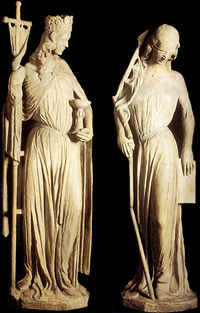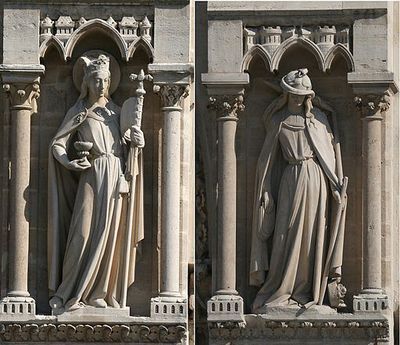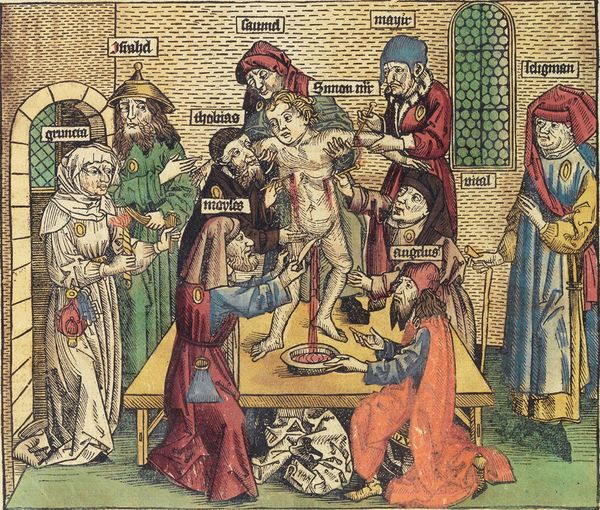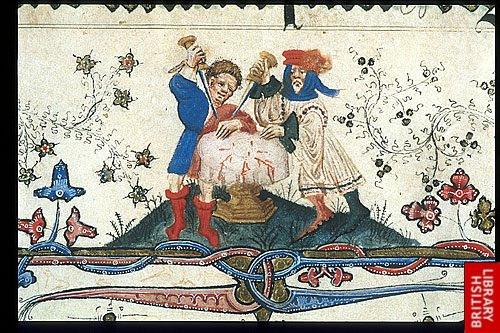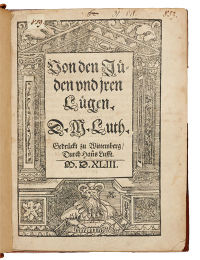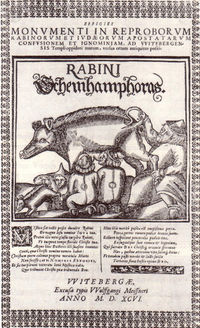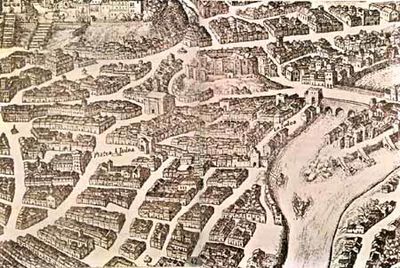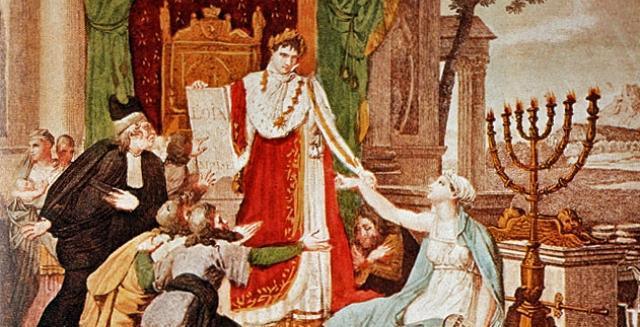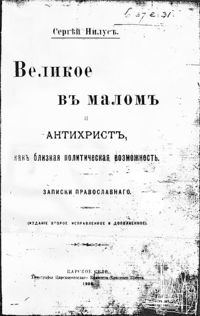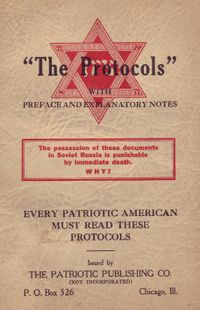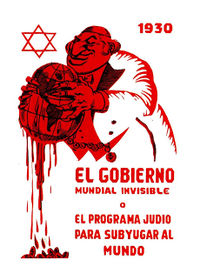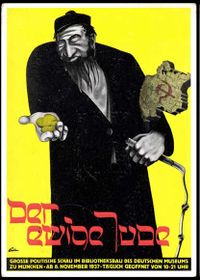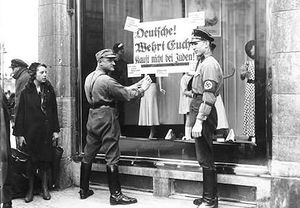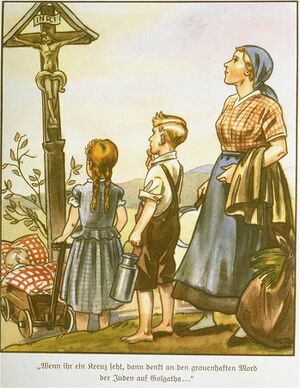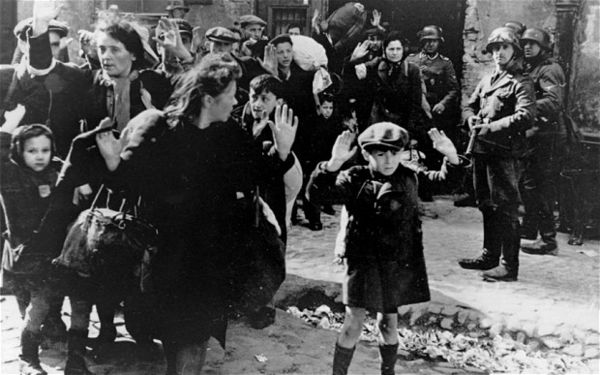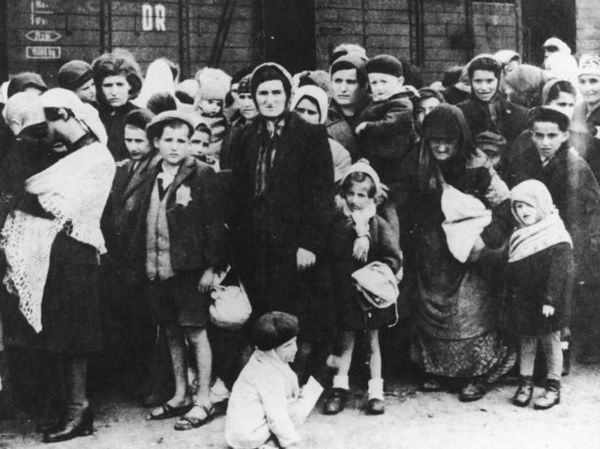Category:Anti-Judaism (subject)
List of scholarly and fictional works on Anti-Judaism and Antisemitism (in chronological order).
Origins of Anti-Judaism
Christianity was born as a Jewish messianic movement. The first Christians were fully aware of their Jewishness:
- Paul: “Has God rejected his people? By no means!… God has not rejected his people whom he foreknew…If some of the branches were broken off, and you, a wild olive shoot, were grafted in their place to share the rich root of the olive tree, do not boast over the branches… Remember that it is not you that support the root, but the root that supports you” (Rom 11)
After the year 70 and the destruction of the Temple gradually parted from the other forms of Judaism. The Jewishness became a matter of controversy even within the Christian movement. On one hand, we have the Gospel of Matthew:
- “I have come not to abolish the Law and the Prophets… but to fulfill… Whoever breaks one of the least of these commandments and teaches others to do the same, will be called least in the kingdom of heaven” (5:17-20).
On the other hand, the term "hoi Ioudaioi" ("the Jews") is used in the Acts of Apostles and especially in the Gospel of John to identify and characterize those who oppose Jesus and/or the movement begun by those Jews who became Jesus's followers. More and more, scholars acknowledge that this locution, especially as used in John and Acts, carries a bias that was born of the increasingly heated struggle for credibility between two strains of first century Judaism, the smaller of which accepted Jesus as Messiah and the larger of which did not. In spite of the fact that Jesus, his disciples, and almost all the central characters involved with Jesus or in the early NT Jesus movement are Jews (as is clear in such passages as John 4.09; 18.15), their opponents are systematically, broadly, and negatively cast as "the Jews."
It must remembered, however, that the "Iudaoioi" are not "all the Jews" but "the Jews of Judea" (or the Hebrews) who for the most have not joined the Jesus movement. The term does not include the Diaspora Jews (or Hellenists) who have joined the Jesus movement. What at the beginning was a conflict within Palestinian Judaism (between the followers of Jesus vs. the Sadducees or the Pharisees) now becomes a conflict between the Hebrews and the Hellenists, or the Jews of Judea" and the Jews of the Diaspora. Luke in particular clearly distinguishes between the Jews in Jerusalem/Judea and those in the Diaspora. The former are held responsible for Jesus' death but not the latter, as is shown by the change from second (chaps. 2-7) to third (chaps. 10-13) persons. The speeches to the Gentiles (chaps. 14, 17) contain no references to the death of Jesus.
The most radical position is that taken by the Letter of Barnabas. God has indeed rejected the people of Israel, who were superseded by the Christians as the new "people of God":
- Some people are wrong “saying that the covenant is both theirs and ours. For it is ours. They (the Jews) permanently lost it…Their covenant was smashed—that the covenant of his beloved, Jesus, might be sealed in our hearts, in the hope brought by faith in him” (4:6-7,10). “They violated [God’s] Law, because an evil angel instructed them...” (9:4).
The parting of the ways between Christianity and Judaism brought about episodes of strong confrontation between the two groups, which led to a mutual estrangement and hatred.
- 42. But when the church came on the scene, and the gospel was set forth, the type lost its value by surrendering its significance to the truth, and the law was fulfilled by surrendering its significance to the gospel. Just as the type lost its significance by surrendering its image to that which is true by nature, and as the parable lost its significance by being illumined through the interpretation, 43. so indeed also the law was fulfilled when the gospel was brought to light, and the people lost their significance when the church came on the scene, and the type was destroyed when the Lord appeared. Therefore, those things which once had value are today without value, because the things which have true value have appeared. (Melito of Sardi, 160-170 ca.).
Exclusion of Jews from the Roman Christian Empire
The Theodosian Code (438 BE)
The Justinian Code (527-565 CE)
Medieval Anti-Judaism
The rise of Christianity to official religion of the Roman empire unlashed anti-Judaism:
The Middle Ages saw the spreading of malicious prejudices against the Jews. They were falsely accused of kidnapping Christian children for bloody sacrifices (Blood Libel).
They were falsely accused of acting against the symbols of Christianity (Host Desecration).
As a result, thousands of Jews were persecuted, murdered, condemned to the stake:
The Ghettos
In 1543 Luther published an Antisemitic pamphlet, On the Jews and Their Lies, in which he says that the Jews are a "base, whoring people, that is, no people of God, and their boast of lineage, circumcision, and law must be accounted as filth." They are full of the "devil's feces ... which they wallow in like swine." The synagogue was a "defiled bride, yes, an incorrigible whore and an evil slut ..." He argues that their synagogues and schools be set on fire, their prayer books destroyed, rabbis forbidden to preach, homes razed, and property and money confiscated. They should be shown no mercy or kindness, afforded no legal protection, and these "poisonous envenomed worms" should be drafted into forced labor or expelled for all time. He also seems to advocate their murder, writing "[w]e are at fault in not slaying them". A few months later, Luther wrote another antisemitic pamphlet (Vom Schem Hamphoras), in which he again argued that the Jews were no longer the chosen people but "the devil's people". Luther's writings would be used extensively by the Nazis.
In 1555, Pope Paul IV issued papal bull “Cum nimis absurdum which created the Ghettoes, city quarters where the Jews were forced to live, segregated from the rest of the population.
Only after the French Revolution (1789), Jews obtained civil rights in some parts of Europe and ghettoes were abolished:
The Holocaust
The worst however had yet to come. Anti-Semitism spread throughout Europe by the end of the 19th century. In 1903 an anonymous pamphlet, The Protocols of the Elders of Zion, falsely accused the Jews of plotting for world domination. This antisemitic hoax was first published in Russia, but was soon translated in all major languages and circulated throughout the world, including the United States, where Henry Ford funded printing of 500,000 copies in the 1920s.
Antisemitism led in the 1930s to the emanation of racial laws against the Jews by Fascist regimes in many European states, notably, Germany and Italy. Jews were commonly excluded by many Universities and social clubs even in democratic countries like the United States.
During the Holocaust, 6,000,000 Jews were murdered:
The Beginning of the Christian-Jewish dialogue
After WW2, relations between Jews and Christian have radically improved.
In the Vatican II a document, called Nostra Aetate (1965), was approved by the Catholic Church, condemning antisemitism and calling for a relations between Christians and Jews based on mutual respect and friendship.
- "Sounding the depths of the mystery which is the Church, this sacred Council remembers the spiritual ties which link the people of the New Covenant to the stock of Abraham. Indeed the Church reproves every form of persecution against whomsoever it may be directed. Remembering, then, her common heritage with the Jews and moved not by any political consideration, but solely by the religious motivation of Christian charity, she deplores all hatreds, persecutions, displays of antisemitism leveled at any time or from any source against the Jews."
Today It has become common to see Christian, Jewish and Muslim leaders praying together and taking part in common celebrations.
References (articles)
- H. R. Moehring, “The Persecution of the Jews and the Adherents of the Isis Cult at Rome A.D. 19,” NT 3 (1959) 293–304.
- Shaye J.D. Cohen, Anti-Semitism in Antiquity, in: History and Hate (ed. D. Berger; Philadelphia, Pa. 1986) 43–48
- Emilio Gabba, “The Growth of Anti-Judaism or the Greek Attitude Towards Jews, CHJ 2 (1989) 614–56.
- Z. Yavetz, Judeophobia in Classical Antiquity: A Different Approach, JJS 44 (1993) 1–22
- John J. Collins, Anti-Semitism in Antiquity?, in Jewish Cult and Hellenistic Culture (JSJSup 100; Leiden 2005) 181–201
Essential Bibliography
External links
Pages in category "Anti-Judaism (subject)"
The following 11 pages are in this category, out of 11 total.
1
2
- Anti-Judaism and the Fourth Gospel (2001 Bieringer), edited volume
- The Invention of Racism in Classical Antiquity (2004 Isaac), book
- Identity Matters: John, the Jews, and Jewishness (2005 Hakola), book
- Apocalypticism, Anti-Semitism and the Historical Jesus (2005 Kloppenborg, Marshall), edited volume
- Pontius Pilate, Anti-Semitism, and the Passion in Medieval Art (2009 Hourihane), book
- The Image of the Jews in Greek Literature: The Hellenistic Period (2010 Bar-Kochva), book
- Raymond Brown, 'The Jews,' and the Gospel of John: From Apologia to Apology (2015 Cronin), book
Media in category "Anti-Judaism (subject)"
The following 39 files are in this category, out of 39 total.
- 1934 * Parkes.jpg 320 × 499; 24 KB
- 1935 Williams.jpg 907 × 1,360; 112 KB
- 1962 * Isaac.jpg 382 × 499; 28 KB
- 1964-T * Isaac en.jpg 768 × 1,024; 207 KB
- 1965 Flannery.jpg 296 × 445; 15 KB
- 1974 * Ruether.jpg 338 × 499; 33 KB
- 1975 Abel.jpg 833 × 1,200; 203 KB
- 1975 Sevenster.jpg 334 × 499; 13 KB
- 1976-T Morais en.jpg 400 × 602; 41 KB
- 1978 Sandmel 2.jpg 266 × 399; 20 KB
- 1979-E Davies.jpg 1,027 × 1,500; 110 KB
- 1982 Williamson.jpg 324 × 499; 42 KB
- 1983 * Gager.jpg 324 × 499; 27 KB
- 1985 Beck.jpg 337 × 499; 14 KB
- 1986-E * Richardson Wilson.jpg 598 × 886; 44 KB
- 1991 * Maccoby.jpg 914 × 1,421; 434 KB
- 1991 Wistrich.jpg 328 × 500; 41 KB
- 1992 Smiga.jpg 322 × 499; 23 KB
- 1993-E Evans Hagner.jpg 329 × 499; 29 KB
- 1993 * Feldman.jpg 333 × 499; 18 KB
- 1993 Hall.jpg 333 × 499; 22 KB
- 1994 Freudmann.jpg 324 × 499; 22 KB
- 1994 Setzer.jpg 324 × 499; 38 KB
- 1995 Taylor.jpg 180 × 284; 7 KB
- 1997 * Schafer.jpg 321 × 500; 29 KB
- 1999-E Farmer.jpg 333 × 499; 36 KB
- 2001 * Carroll.jpg 328 × 499; 39 KB
- 2002-E Fredriksen Reinhartz.jpg 333 × 499; 39 KB
- 2002 Perry Schweitzer.jpg 400 × 599; 57 KB
- 2005-E Levy.jpg 400 × 517; 168 KB
- 2006 Laqueur.jpg 400 × 605; 243 KB
- 2007 Cohen.jpg 400 × 608; 159 KB
- 2008 * Heschel.jpg 329 × 500; 20 KB
- 2010 Donaldson.jpg 318 × 499; 29 KB
- 2010 Wistrich.jpg 400 × 608; 36 KB
- 2012 Goldstein.jpg 400 × 595; 28 KB
- 2013 Nirenberg.jpg 400 × 599; 26 KB
- 2018 Reinhartz.jpg 314 × 499; 29 KB
- 2022-E * Katz.jpg 400 × 607; 367 KB
